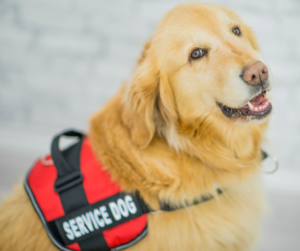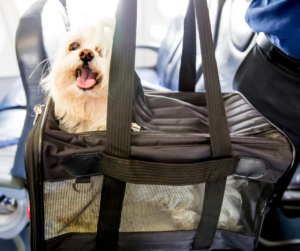Different Types of Working Dogs – Do You Know the Difference?
Did you know that there is a difference between a Service Animal, a Guide Dog, a Therapy Dog, and an Emotional Support Animal? It’s OK if you didn’t – many people often get the different types of working animals confused. In honor of National Guide Dog Month, Clovernook Center for the Blind & Visually Impaired put together information on each and what they do for their handlers.
 Service Animal/Dog
Service Animal/Dog
Under federal law, a Service Animal is a dog (and in some cases a miniature horse) that has been task-trained to assist a person with a disability. Service Animals are the only type of working animals that are allowed to accompany their handler into public accommodations. Many of these dogs have had extensive training to learn the skills needed for their jobs. They have impeccable manners in public settings and have been very well socialized; having positive interactions with people as well as other animals. Service dogs are not pets but trained to help mitigate disability and are exempt from general restrictions that apply to pets.
There are several types of Service dogs, some include:
- Guide Dogs for the Blind
- Hearing Dogs
- Diabetic Alert Dogs
- Seizure Alert Dogs
- PTSD Dogs
- Wheelchair Assistance Dogs
- Dogs to help children with Autism
 Therapy Dog
Therapy Dog
A therapy dog is a dog that offers affection, comfort, and stress relief to a group of individuals. These dogs are commonly seen in nursing homes, schools, courtrooms, and hospitals. These dogs help multiple people throughout their workday; they do not solely provide comfort to their handlers. These dogs are usually certified and evaluated by therapy dog organizations. Therapy dogs are trained to master certain skills and must have a very good disposition. Therapy dog handlers are only allowed to enter public spaces with permission; they do not have the same access rights as people with disabilities using a service dog.
 Emotional Support Animal
Emotional Support Animal
An emotional support animal is an animal that provides emotional support and comfort to an individual. Emotional support animals (ESA) do not have specific training and are generally not limited to a certain species. ESA handlers do not have public access rights with their animals as service dogs do. They are only allowed to have these animals in housing, college dormitories, and in some cases on airplanes.
What the Law Allows and Why It’s Important
The Americans with Disabilities Act (ADA) is the Federal Law that pertains to people with disabilities. Under the ADA, people who use a service dog can be accompanied by the dog in all areas that the general public is allowed. A few examples of these places would include hospitals, retail stores, restaurants, hotels, schools, concert halls, buses, trains, taxis, gyms, museums, and amusement parks. Examples of an area that one cannot be accompanied by their service dog would be a place where the dog’s presence may compromise a sterile environment; such as an operating room or a burn unit.
 People with guide dogs have the freedom to travel safely to so many places. However, in recent years individuals with disabilities have faced a huge problem with public access due to individuals labeling their pets as “service animals.” Misrepresenting a pet as a service dog is against the law and has serious consequences for people with disabilities who rely on trained service dogs for independence. If an aggressive pet dog inside a grocery store growls and tries to attack a working guide dog; the guide dog may become fearful and may no longer be able to work. Years of hard work can be lost by one single incident/encounter with an animal not properly trained to be a service animal.
People with guide dogs have the freedom to travel safely to so many places. However, in recent years individuals with disabilities have faced a huge problem with public access due to individuals labeling their pets as “service animals.” Misrepresenting a pet as a service dog is against the law and has serious consequences for people with disabilities who rely on trained service dogs for independence. If an aggressive pet dog inside a grocery store growls and tries to attack a working guide dog; the guide dog may become fearful and may no longer be able to work. Years of hard work can be lost by one single incident/encounter with an animal not properly trained to be a service animal.
Businesses can legally ask a person with a service dog (regardless of whether or not it is a legitimately trained animal) to leave their business if the animal is disruptive and its handler doesn’t take immediate action to control a problem or correct behavior. Fraudulent service dogs cause confusion around the laws and can pose a serious threat to the safety of working service dogs by increasing the amount of discrimination imposed on individuals that rely on service animals for independence. According to Canine Companions for Independence, 52% of service dog program users feel that their quality of life and independence has been impacted by fraudulent service dogs.

The biggest way to combat service dog fraud is to educate yourself on the differences between the two and become an advocate against them. Canine Companions for Independence has developed an advocacy initiative to protect the organization, its volunteers, and the rights of our graduates from laws or regulations that would negatively impact our community. The initiative also aims to improve access and safety for all Americans with disabilities who rely on task-trained service dogs through strengthened public and corporate policy.
Thank you for doing your part to help spread awareness and supporting our working dogs during National Guide Dog Month! Did you miss any of our previous guide dog installments? Click below to read more:
- Guide Dog Etiquette: What You Should and Shouldn’t Do – Did you know you should never let your dog interact with a guide dog?
- The Labor of Being a Guide Dog – Learn about how a guide dog helps their owner navigate a typical day.
- Difference Between a Guide Dog and Utilizing a White Cane – Learn about the pros and cons of both modes of travel.
